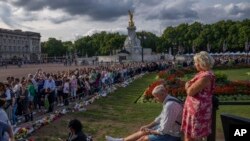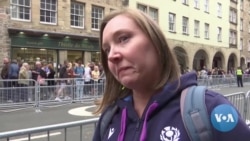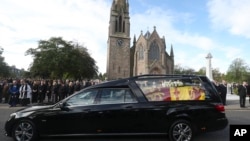The body of Britain’s Queen Elizabeth II has been taken from Balmoral Castle in Scotland, where she died Thursday, to Edinburgh. Over the coming days, members of the public will have the opportunity to visit the coffin and pay their respects to Elizabeth, who held the British throne for seven decades.
The hearse, accompanied by royal officials and security personnel, left Balmoral Castle shortly before midday Sunday, the beginning of Elizabeth’s long and final journey to lay in peace.
Balmoral
The convoy tracked slowly through the majestic Scottish hills, a landscape treasured by the late monarch, where she spent her final peaceful weeks of life. In years past, the queen was frequently seen visiting these remote Scottish villages when she resided at Balmoral Castle, an area she loved – and she was well loved in return.
Residents gathered on the roadside to glimpse her for the last time and to say goodbye. The silence spoke of the shock that is still felt at her passing – and the respect in which the late queen was held in communities across Britain.
Some onlookers threw flowers as the hearse passed by; many in the crowd shed tears. Gentle ripples of applause followed as the convoy continued southward.
Emotional farewell
"We've known (her) for all our lives. So, it's been the one constant thing in the whole of our lives - the queen,” said Stephanie Cook, a resident of the village of Ballater, close to Balmoral.
After a six-hour journey, the hearse crossed the River Forth toward the Scottish capital, Edinburgh. Along the Scottish capital’s Royal Mile, thousands waited to see the cortege.
Fiona Moffat traveled from Glasgow to witness the moment. She fought back tears as she described her emotions.
“A very historic moment. I am quite speechless actually. She was a lovely lady. Great mother, grandmother. She did well. I am very proud of her,” Moffat told The Associated Press.
Elaine Robertson, visiting Edinburgh from her home in Ayr on Scotland’s west coast, was also in tears. “I think it is just important to be here. Just important to say goodbye. She has been on the throne for a long time. So, yes, it means a lot,” Robertson said.
Lie in state
The coffin will lie in Edinburgh’s St. Giles Cathedral, where members of the public will be invited to pay their respects.
On Tuesday, the queen’s body will be flown to London. It will first be taken to Buckingham Palace, and then transferred in a public procession led by Elizabeth’s son, King Charles III, to the 11th-century Westminster Hall, where she will lie in state for four days. The hall will be open 23 hours a day for visitors. It will be guarded by soldiers from the royal household.
Tens of thousands of people are expected to travel to Westminster to pay their respects.
“She has been an exemplary head of state in terms of her devotion to her people and to her job,” said royal historian and author Robert Lacey. “And then I think the other thing to take away, which is inevitable in all these crowds and expressions of emotion, it's the enduring command that the British monarchy holds over the emotions of people in Britain,” Lacey told The Associated Press.
The funeral is scheduled for Monday, September 19 at Westminster Abbey. The coffin will then be taken to Windsor for the committal service, where the queen’s husband, Prince Philip, was laid to rest in April 2021.














